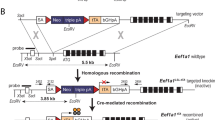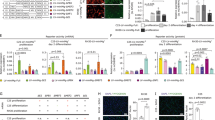Abstract
The conditional expression of lethal genes in tumor cells is a promising gene therapy approach for the treatment of cancer. The identification of promoters that are preferentially active in cancer cells is the starting point for this strategy. The combination of tissue-specific and tumor-specific elements offers the possibility to artificially develop such promoters. We describe the construction and characterization of a hybrid promoter for transcriptional targeting of breast cancer. In many cases, breast cancer cells retain the expression of estrogen receptors, and most solid tumors suffer from hypoxia as a consequence of their aberrant vascularization. Estrogen response elements and hypoxia-responsive elements were combined to activate transcription in cells that present at least one of these characteristics. When a promoter containing these elements is used to control the expression of the pro-apoptotic gene harakiri, the induction of cell death can be activated by estrogens and hypoxia, and inhibited by antiestrogens such as tamoxifen. Finally, we show evidence that these properties are maintained in the context of an adenoviral vector (AdEHhrk). Therefore, infection with this virus preferentially kills estrogen receptor–positive breast cancer cells, or cells growing under hypoxic conditions. We propose the use of this promoter for transcriptional targeting of breast cancer. Cancer Gene Therapy (2001) 8, 298–307
This is a preview of subscription content, access via your institution
Access options
Subscribe to this journal
Receive 12 print issues and online access
$259.00 per year
only $21.58 per issue
Buy this article
- Purchase on Springer Link
- Instant access to full article PDF
Prices may be subject to local taxes which are calculated during checkout
Similar content being viewed by others
References
Roth J, Cristiano R . Gene therapy for cancer: what have we done and where are we going? J Natl Cancer Inst 1997; 89:: 21–39
Dranoff G . Cancer gene therapy: connecting basic research with clinical inquiry J Clin Oncol 1998; 16:: 2548–2556
Hart I . Tissue-specific promoters in targeting systemically delivered gene therapy Semin Oncol 1996; 23:: 154–158
Kanai F, Lan K, Shiratori Y, et al . In vivo gene therapy for α-Fetoprotein–producing hepatocellular carcinoma by adenovirus-mediated transfer of cytosine deaminase gene Cancer Res 1997; 57:: 461–465
Cao G, Kuriyama S, Gao J, et al . Effective and safe gene therapy for colorectal carcinoma using the cytosine deaminase gene directed by the carcinoembryonic antigen promoter Gene Ther 1999; 6:: 83–90
Lan K, Kanai F, Shiratori Y, et al . In vivo selective gene expression and therapy mediated by adenoviral vectors for human carcinoembryonic antigen-producing gastric carcinoma Cancer Res 1997; 57:: 4279–4284
Hallenbeck P, Chang Y, Hay C, et al . A novel tumor-specific replication-restricted adenoviral vector for gene therapy of hepatocellular carcinoma Hum Gene Ther 1999; 10:: 1721–1733
Yu D, Sakamoto GT, Henderson DR . Identification of the transcriptional regulatory sequences of human Kallikrein 2 and their use in the construction of Calydon Virus 764, an attenuated replication-competent adenovirus for prostate cancer therapy Cancer Res 1999; 59:: 1498–1504
Cao G, Zhang X, He X, et al . A safe, effective in vivo gene therapy for melanoma using tyrosinase promoter-driven cytosine deaminase gene In Vivo 1999; 13:: 181–187
Cheon J, Ko S, Gardner T, et al . Chemogene therapy: osteocalcin promoter-based suicide gene therapy in combination with methotrexate in a murine osteosarcoma model Cancer Gene Ther 1997; 4:: 359–365
Anderson LM, Swaminathan S, Zackon I, et al . Adenovirus-mediated tissue-targeted expression of the HSVtk gene for the treatment of breast cancer Gene Ther 1999; 6:: 854–864
Anderson LM, Krotz S, Weitzman, et al . Breast cancer-specific expression of the Candida albicans cytosine deaminase gene using a transcriptional targeting approach Cancer Gene Ther 2000; 7:: 845–852
Brugger W, Buhring HJ, Grunebach F, et al . Expression of MUC-1 epitopes on normal bone marrow: implications for the detection of micrometastatic tumor cells J Clin Oncol 1999; 17:: 1535–1544
Kurihara T, Brough DE, Kovesdi I, et al . Selectivity of a replication-competent adenovirus for human breast carcinoma cells expressing the MUC-1 antigen J Clin Invest 2000; 106:: 763–771
Hernandez-Alcoceba R, Pihalja M, Wicha MS, et al . A novel, conditionally replicative adenovirus for the treatment of breast cancer that allows controlled replication of E1a-deleted adenoviral vectors Hum Gene Ther 2000; 11:: 2009–2024
Ekena K, Katzenellenbogen JA, Katzenellenbogen BS . Determinants of ligand specificity of estrogen receptor-α: estrogen versus androgen discrimination J Biol Chem 1998; 273:: 693–699
Valavaara R . Reliability of estrogen receptors in predicting response to antiestrogens Oncology 1997; 11:: 14–18
Zhong H, De Marzo AM, Laughner E, et al . Overexpression of hypoxia-inducible factor 1 alpha in common human cancers and their metastases Cancer Res 1999; 59:: 5830–5835
Talks KL, Turley H, Gatter KC, et al . The expression and distribution of the hypoxia-inducible factors HIF-1 alpha and HIF-2 alpha in normal tissues, cancers, and tumor-associated macrophages Am J Pathol 2000; 157:: 411–421
Bunn HF, Poyton R . Oxygen sensing and molecular adaptation to hypoxia Physiol Rev 1996; 76:: 839–879
Maxwell PH, Dachs GU, Gleadle JM, et al . Hypoxia-inducible factor-1 modulates gene expression in solid tumors and influences both angiogenesis and tumor growth Proc Natl Acad Sci USA 1997; 94:: 8104–8109
Ryan HE, Poloni M, McNulty W, et al . Hypoxia-inducible factor-1 alpha is a positive factor in solid tumor growth Cancer Res 2000; 60:: 4010–4015
Dachs GU, Patterson AV, Firth JD, et al . Targeting gene expression to hypoxic tumor cells Nat Med 1997; 3:: 515–520
Ruan H, Wang J, Hu L, et al . Killing of brain tumor cells by hypoxia-responsive element–mediated expression of BAX Neoplasia 1999; 1:: 431–437
Modlich U, Pugh CW, Bicknell R . Increasing endothelial cell–specific expression by the use of heterologous hypoxic and cytokine-inducible enhancers Gene Ther 2000; 7:: 896–902
Green DR . Apoptotic pathways: paper wraps stone blunts scissors Cell 2000; 102:: 1–4
Adams JM, Cory S . The Bcl-2 protein family: arbiters of cell survival Science 1998; 281:: 1322–1326
Gibson LF, Fortney J, Magro G, et al . Regulation of BAX and BCL-2 expression in breast cancer cells by chemotherapy Breast Cancer Res Treat 1999; 55:: 107–117
Clarke M, Apel I, Benedict M, et al . A recombinant bcl-xs adenovirus selectively induces apoptosis in cancer cells but not in normal bone marrow cells Proc Natl Acad Sci USA 1995; 92:: 11024–11028
Ealovenga M, McGinnis P, Sumantran V, Clarke M, Wicha M . Bcl-xs gene therapy induces apoptosis of human mammary tumors in nude mice Cancer Res 1996; 56:: 1965–1969
Shinoura N, Muramatsu Y, Yoshida Y, et al . Adenovirus-mediated transfer of caspase-3 with Fas ligand induces drastic apoptosis in U373MG glioma cells Exp Cell Res 2000; 256:: 423–433
Inohara N, Ding L, Chen S, et al . Harakiri, a novel regulator of cell death, encodes a protein that activates apoptosis and interacts selectively with survival-promoting proteins Bcl-2 and Bcl-X L EMBO J 1997; 16:: 1686–1694
Montano MM, Ekena K, Krueger KD, et al . Human estrogen receptor ligand activity inversion mutants: receptors that interpret antiestrogens as estrogens and estrogens as antiestrogens and discriminate among different antiestrogens Mol Endocrinol 1996; 10:: 230–242
Aoki K, Barker C, Danthinne X, et al . Efficient generation of recombinant adenoviral vectors by Cre–Lox recombination in vitro Mol Med 1999; 5:: 224–231
Vassaux G, Hurst HC, Lemoine NR . Insulation of a conditionally expressed transgene in an adenoviral vector Gene Ther 1999; 6:: 1192–1197
Shi Q, Wang Y, Worton R . Modulation of the specificity and activity of a cellular promoter in an adenoviral vector Hum Gene Ther 1997; 8:: 403–410
Carmichael J, DeGraff WG, Gazdar AF, et al . Evaluation of a tetrazolium-based semiautomated colorimetric assay: assessment of chemosensitivity testing Cancer Res 1987; 47:: 936–942
Nieves-Neira W, Pommier Y . Apoptotic response to campothecin and 7-hydroxystaurosporine (UCN-01) in the 8 human breast cancer cell lines of the NCI anticancer drug screen: multifactorial relationships with topoisomerase I, protein kinase C, Bcl-2, p53, MDM-2, and caspase pathways Int J Cancer 1999; 82:: 396–404
Peng K, Vile R . Vector development for cancer gene therapy Tumor Targeting 1999; 4:: 3–11
Hermiston T . Gene delivery from replication-selective viruses: arming guided missiles in the war against cancer J Clin Invest 2000; 105:: 1169–1172
Velculescu V, Zhang L, Vogelstein B, et al . Serial analysis of gene expression Science 1995; 270:: 484–487
Nacht M, Ferguson AT, Zhang W, et al . Combining serial analysis of gene expression and array technologies to identify genes differentially expressed in breast cancer Cancer Res 1999; 59:: 5464–5470
Nettelbeck DM, Jerome V, Muller R . A dual-specificity promoter system combining cell cycle–regulated and tissue-specific transcriptional control Gene Ther 1999; 6:: 1276–1281
Motoi F, Sunamura M, Ding L, et al . Effective gene therapy for pancreatic cancer by cytokines mediated by restricted replication-competent adenovirus Hum Gene Ther 2000; 11:: 223–235
Acknowledgements
We thank N. Inohara for the pcDNA3-hrk plasmid, D. Qiang for technical support, the University of Michigan vector core for assistance in the construction of the AdEHhrk virus, and Laurie Kittl for correction of the manuscript. This work was supported by NIH Grants PO1 CA 75136 (to M.C. and G.N.) and CA 67140 (to M.C.).
Author information
Authors and Affiliations
Corresponding author
Rights and permissions
About this article
Cite this article
Hernandez-Alcoceba, R., Pihalja, M., Nunez, G. et al. Evaluation of a new dual-specificity promoter for selective induction of apoptosis in breast cancer cells. Cancer Gene Ther 8, 298–307 (2001). https://doi.org/10.1038/sj.cgt.7700304
Published:
Issue Date:
DOI: https://doi.org/10.1038/sj.cgt.7700304
Keywords
This article is cited by
-
RETRACTED ARTICLE: Transcriptional retargeting of herpes simplex virus for cell-specific replication to control cancer
Journal of Cancer Research and Clinical Oncology (2018)
-
Tumor immune surveillance and ovarian cancer
Cancer and Metastasis Reviews (2011)
-
Suppression of Cancer Growth by Nonviral Gene Therapy Based on a Novel Reactive Oxygen Species-responsive Promoter
Molecular Therapy (2009)
-
Novel chimeric gene promoters responsive to hypoxia and ionizing radiation
Gene Therapy (2002)
-
Hypoxia and oxidative stress in breast cancer Tumour hypoxia – therapeutic considerations
Breast Cancer Research (2001)



